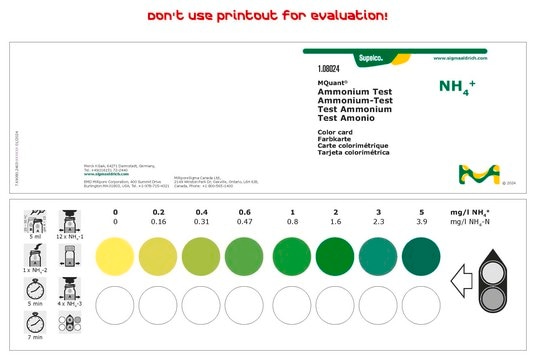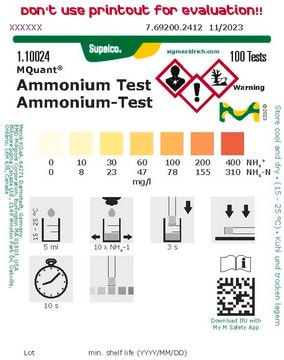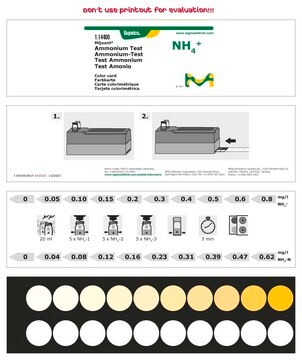The exact percentages as exact reagent composition are proprietary. The composition can be provided in ranges as follows; Reagent A: Contains 1-15% o-phthalaldehyde, CAS #: 643-79-8, and 10-99% dimethyl sulfoxide, CAS#: 67-68-5. Reagent B: Contains 0.1-5% β-Mercaptoethanol, CAS#: 60-24-2, and 10-99% dimethyl sulfoxide, CAS#: 67-68-5.
MAK310
Ammonia Assay Kit
sufficient for 200 fluorometric tests
Synonym(s):
Ammonia Quantitative Test Kit
About This Item
Recommended Products
detection method
fluorometric
relevant disease(s)
genitourinary disorders; gastrointestinal diseases
storage temp.
−20°C
General description
Features and Benefits
Suitability
Principle
Signal Word
Danger
Hazard Statements
Precautionary Statements
Hazard Classifications
Acute Tox. 4 Oral - Aquatic Acute 1 - Aquatic Chronic 1 - Eye Dam. 1 - Skin Corr. 1B - Skin Sens. 1
Storage Class Code
8A - Combustible corrosive hazardous materials
Flash Point(F)
188.6 °F
Flash Point(C)
87 °C
Choose from one of the most recent versions:
Certificates of Analysis (COA)
Don't see the Right Version?
If you require a particular version, you can look up a specific certificate by the Lot or Batch number.
Already Own This Product?
Find documentation for the products that you have recently purchased in the Document Library.
Customers Also Viewed
-
What is the composition of reagent A and reagent B supplied with the MAK310 assay kit?
1 answer-
Helpful?
-
-
Can i use this assay kit to determine the ammonia amount of culture media sample? (RPMI-1640)
1 answer-
This kit has not been tested for use with cell culture samples or supernatants, including those containing RPMI-1640. Amine-containing buffers such as Tris buffers should be avoided. In addition, high protein concentrations may interfere with the reaction. The end user would have to determine suitability. Product MAK538, Ammonia Assay Kit, would be a more suitable product for use in cell culture applications. Please see the link below to review this product option:
https://www.sigmaaldrich.com/product/sigma/mak538Helpful?
-
-
What is the recommended protocol for the storage and freeze/thaw of the ammonia assay kit (MAK310)? Is it permissible to aliquot portions in advance, or is the kit stable for a certain period of time at 4°C? Furthermore, what is the optimal method for thawing the kit (on ice)? Additionally, what is the shelf life of the reagents once thawed? Should the thawed "working" reagents be stored at 4°C or room temperature until they are used (within the timeframe of the above question)?
1 answer-
It is advisable to aliquot portions of the reagents in advance to minimize the number of freeze-thaw cycles. Thawing the components at room temperature is acceptable. But, there is no specific data available regarding the stability of the reagents once they are thawed. It is recommended to prepare smaller aliquots of the reagents, enough for the number of assays the customer intends to run, to avoid having an excessive amount of reagent after an experiment. While it is acceptable to refreeze the leftover aliquots for future use, it is advisable to minimize multiple freeze-thaw cycles. The reagents may be temporarily stored at 4°C if necessary during an experiment. Additionally, it is recommended to create a standard curve according to the protocol, and if the curve is linear, then the kit should be functioning properly.
Helpful?
-
-
Can this kit chemistry be used directly with serum samples, or will the protein content interfere with the assay?
1 answer-
The kit chemistry cannot be used directly with serum samples. Deproteinization is necessary before running the assay, and this can be achieved by passing the sample through 10 kDa cutoff filters. Alternatively, proteins can be chemically precipitated using TCA, although this method has not been tested with this kit. If using acid for protein separation, it is important to neutralize the sample with a base before running the assay.
Helpful?
-
-
To calculate the molarity of my samples, do I need to multiply it by the dilution factor of the final reaction volume? According to technical bulletin, standards are diluted 1/10 at final molarity of .1 mM at the highest point of the curve.
1 answer-
If 10 uL of undiluted sample is used before adding the 90 uL of working reagent, then no dilution factor is needed. The dilution factor is only needed if the sample has been diluted before the pipetting for 10 uL into the sample well. For example, if the kit is used and the ammonia concentration is 1 mM or greater, it is necessary to dilute the sample in water and repeat the assay. Multiply the results by the dilution factor. If the sample is diluted 10-fold, then a dilution factor of '10' would need to be applied to the results.
Helpful?
-
-
Is this a stand alone test or does it require external instrumentation?
1 answer-
A 96 well plate is not included in this kit. A plate reader is also required. Please see the 'Reagents and Equipment Required but Not Provided with this kit' on the Product Information Sheet:
https://www.sigmaaldrich.com/deepweb/assets/sigmaaldrich/product/documents/196/522/mak310bul.pdfHelpful?
-
-
Is this kit suitable for seawater samples?
1 answer-
Yes, the Ammonia Assay Kit provides a simple and high throughput adaptable assay for quantitative determination of ammonia/ammonium ion concentration in biological samples, such as urine, and environmental samples.
Helpful?
-
Active Filters
Our team of scientists has experience in all areas of research including Life Science, Material Science, Chemical Synthesis, Chromatography, Analytical and many others.
Contact Technical Service












